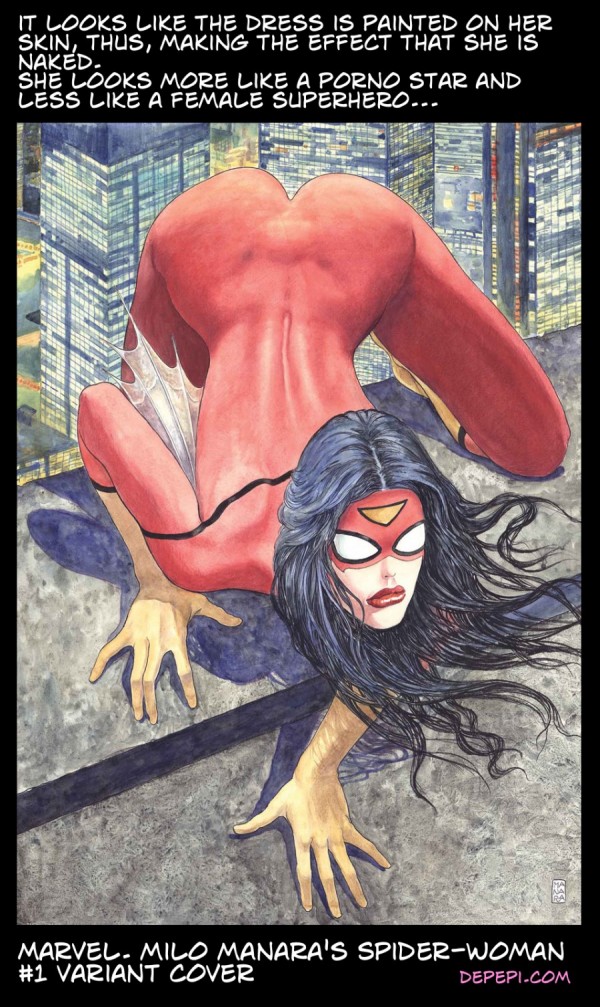 BY STEPHANIE SHAMP GEEKS SPACE CORRESPONDENT Have you ever realized that you’ve been looking at something for years but have never really seen it? I’m talking about those hidden messages we always glance over but never really notice until someone points it out, like the Starbucks cup hidden in every frame of Fight Club or the arrow pointing from A to Z in the Amazon logo. For as long as I have been a fan of comics there has always been this look-but-don’t-see mentality towards the scantily-clad sexism of comic books starring women, specifically the cover art. If you point it out to the comic book community people immediately become annoyed and defensive. ‘It’s always been like that, what do you expect?’ they say, or ‘Men’s bodies get distorted too!’ But these excuses don’t really apply to the way female-led comics are sold or address how it could at all be detrimental to the comic.
BY STEPHANIE SHAMP GEEKS SPACE CORRESPONDENT Have you ever realized that you’ve been looking at something for years but have never really seen it? I’m talking about those hidden messages we always glance over but never really notice until someone points it out, like the Starbucks cup hidden in every frame of Fight Club or the arrow pointing from A to Z in the Amazon logo. For as long as I have been a fan of comics there has always been this look-but-don’t-see mentality towards the scantily-clad sexism of comic books starring women, specifically the cover art. If you point it out to the comic book community people immediately become annoyed and defensive. ‘It’s always been like that, what do you expect?’ they say, or ‘Men’s bodies get distorted too!’ But these excuses don’t really apply to the way female-led comics are sold or address how it could at all be detrimental to the comic.
The comic book industry has always been a judge-by-the-cover business; this should come as a surprise to literally no one. Cover art serves the dual purpose of summarizing in a single image the issue’s story arc for the acolytes while seducing new initiates into the fold. Then there are the variant covers for the same issue which can have legendary guest artists, holographic or 3D art, promote a company-wide event—all these amazing little extras drive up sale prices and potentially draw in new readers to keep the series going. Covers can make or break a comic for readers, publishers, and, both directly and indirectly, movie or television studios. So why is it that while male superheroes appear on their covers imposing and heroic, ready to leap into danger and kick ass, female superheroes are drawn in vulnerable or seductive positions, able to defy the anatomical limits of the human spine to give horny teenage boys that perfect view of tits and ass?
Because for far too long the comic book industrial complex has been ruled by the chauvinistic dictum that sex sells. Hey, these are hot women in spandex how else are you going to market them? Yes, of course sex sells, but it’s the laziest marketing form there is (Don Draper wouldn’t even consider it). Message: female superheroes have nothing to really contribute to the comic book universe but at least they’re nice to look at and make great love interests for the heroes of “real” comics. These hypersexualized covers–released faithfully every Wednesday–may well be self-defeating, dissuading the casual reader from exploring other female-led titles because they are expecting the same clichéd chick superhero stories where distorted female anatomy distracts from the actual plot. Or, even worse, the female body is the plot (think Psylocke’s entire existence or Ms. Marvel getting knocked up by her own son, ugh).
This is not to say there haven’t been improvements. The industry is showing belated signs of awareness that A) the audience for comic books is no longer exclusively male, and B) not all consumers, male or female, want mindless entertainment with handsome people fighting crime in sexy poses. New readers have entered an era of comics where they have a lot of options, if the mainstream comics aren’t selling them the super-powered woman comic they want they can look elsewhere and find independent comics that put gender second to plot, such as Greg Rucka & Michael Lark’s Lazarus. The mainstream has wised up…somewhat. On Tuesday, Marvel announced it was its porn-y and much-reviled Spider-Woman series (pictured, above) after just two issues. Comics like J.H. William and W. Haden Blackman’s Batwoman and Brian Azzarello and Cliff Chiang’s Wonder Woman are critically acclaimed titles from DC’s “New 52” reboot that have strong female leads whose complicated lives and morals are not dictated by their gender and the cover art clearly reflects that. While that’s great it’s also important to note this is the same publisher who encouraged a sexy Harley-Quinn-suicide-themed cover contest, published the comic that coined the term “Women in Refrigerators,” and just this past June released a series of women of DC pin-up covers.
I realize that comic book publishers have to make often-impossible choices when weighing the vagaries of gender, equality, and opportunity against market realities and human nature. Comic book readers are a tough bunch to convince that there are “girl comics” worth reading. I’m not blaming DC or Marvel or any one specific publisher for this culture of women as objects and men as heroes, there is no blame to place because we all participate in it. I immediately bagged and boarded the Batwoman #32 pin-up issue when I saw it at my local comic shop, the cover is adorable and I love Kate Kane. We’re all at fault. However, if more people start pointing out to the powers that be how their lazy reliance on tired sexist tropes is distracting and discouraging more readers than it’s attracting, well, then maybe we can begin to get our beloved female characters the cover art they deserve, cover art that treats them like people, not things.

